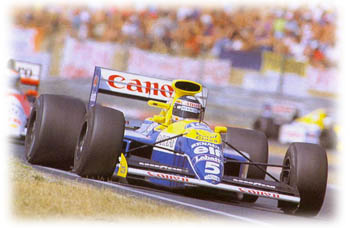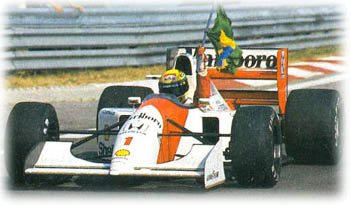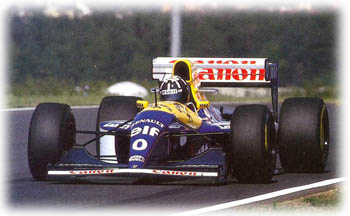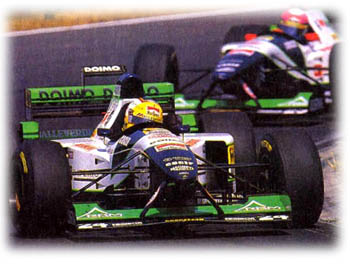|
 The Hungarian Grand Prix has been criticised many times, yet remained on the calendar for 14 years now. The first race had a rather major historic significance: back in 1986, it was the first race ever to be held behind the Iron Curtain. A massive 200,000 crowd attended the event, which saw a fierce battle between Brazilians Nelson Piquet and Ayrton Senna. While Senna took pole, the two were closely battling for the first win in Hungary, changing positions several times during the race. By the end of the two-hours race, Piquet struck a 17-second lead to Senna, with the rest of the field being lapped. Piquet repeated this triumph the year after, beating Senna to the chequered flag by a margin of 37 seconds. The Hungarian Grand Prix has been criticised many times, yet remained on the calendar for 14 years now. The first race had a rather major historic significance: back in 1986, it was the first race ever to be held behind the Iron Curtain. A massive 200,000 crowd attended the event, which saw a fierce battle between Brazilians Nelson Piquet and Ayrton Senna. While Senna took pole, the two were closely battling for the first win in Hungary, changing positions several times during the race. By the end of the two-hours race, Piquet struck a 17-second lead to Senna, with the rest of the field being lapped. Piquet repeated this triumph the year after, beating Senna to the chequered flag by a margin of 37 seconds.
Nonetheless, Senna finally got his win at the Hungaroring in 1988. Much like today, it was the age of the McLarens and Senna's only rival was teammate Alain Prost. And though Senna led the race from start to finish, the gap at the finish line between the two was barely half a second. Senna would remain dominant in Hungary for years to come, but, as the decade turned, it was to be the era of Williams domination.
 The team's streak of wins began with a 1990 surprise: Thierry Boutsen took the last of his three Formula One victories and his only pole position in the strong Williams, even beating Senna - who scored his 4th 2nd position in 5 years - by just 0.288. Senna had it his way the next year, but Williams had the two other spots of the podium with Nigel Mansell and Ricardo Patrese. However, Hungary is, if anything, the place where anything could happen and in that year Bertrand Gachot took the fastest lap with the famous Jordan191 in the debut season of the team. The team's streak of wins began with a 1990 surprise: Thierry Boutsen took the last of his three Formula One victories and his only pole position in the strong Williams, even beating Senna - who scored his 4th 2nd position in 5 years - by just 0.288. Senna had it his way the next year, but Williams had the two other spots of the podium with Nigel Mansell and Ricardo Patrese. However, Hungary is, if anything, the place where anything could happen and in that year Bertrand Gachot took the fastest lap with the famous Jordan191 in the debut season of the team.
In the 1992 race, Ayrton Senna managed to get his third Hungarian victory, scoring seven consecutive podiums there. Meanwhile, Nigel Mansell in the all-too-dominant Williams actually secured his Championship title, as he finished second and earned a 52 points lead after only 11 Grands Prix. And by 1993 Williams introduced yet another Hungary master, with Damon Hill taking his first Formula One win in style, leading Benetton's Riccardo Patrese by more than a minute.
 Hill would finish on the podium in five consecutive Grands Prix he attended in Hungary from that win on. He finished second in the 1994 Grand Prix, which was entirely a Michael Schumacher show. Moreover, after taking pole, fastest lap and win in the Benetton, Schumacher showed he could also be a team player, letting teammate Jos Verstappen unlap himself to take the third in the final lap. Hill would finish on the podium in five consecutive Grands Prix he attended in Hungary from that win on. He finished second in the 1994 Grand Prix, which was entirely a Michael Schumacher show. Moreover, after taking pole, fastest lap and win in the Benetton, Schumacher showed he could also be a team player, letting teammate Jos Verstappen unlap himself to take the third in the final lap.
But 1994 was a temporary relapse and by the following year Williams was back to setting the pace. Damon Hill did the hat trick, and teammate David Coulthard pulled in second with the rest of the pack lapped. The next year Williams was as dominating as the year before. This time Jacques Villeneuve took the win, with Damon Hill coming in second. Only Jean Alesi in the Benetton finished the race on the same lap, but only barely - he had a one minute and 24 second deficit in the end.
For McLaren, Hungary is not a Grand Prix with much good memories in recent years. Since McLaren teamed up with Mercedes in 1995 only two McLarens ever reached the finish line of the Hungaroring: Mika Hakkinen finished fourth in the 1996 Grand Prix and David Coulthard finished second in 1998.
 Speaking of Hakkinen, he didn't drive two of the eight Hungarian Grands Prix of his career: in 1993 he was out of a seat and the following year he was suspended after causing a massive start-line shunt at Hockenheim. For David Coulthard, Hungary didn't bring much more luck: out of five starts, he finished just twice, making last year his best when finishing second behind Ferrari's Michael Schumacher. Speaking of Hakkinen, he didn't drive two of the eight Hungarian Grands Prix of his career: in 1993 he was out of a seat and the following year he was suspended after causing a massive start-line shunt at Hockenheim. For David Coulthard, Hungary didn't bring much more luck: out of five starts, he finished just twice, making last year his best when finishing second behind Ferrari's Michael Schumacher.
That win of Schumacher last year is commonly regarded as one of his best races ever. Through brilliant thinking of Ferrari's technical director Ross Brawn, the plan to make three stops developed during the race. Schumacher's second stop was short, allowing him to take the lead from the McLarens, who had been in front of him up until then. Brawn had calculated Schumacher needed to build up a 25 second gap in the 19 laps between his second and third stop and the German did just that - punching one fastest lap after the other.
Apart from last year, Ferrari doesn't look much better in recent history. Their only other win in Hungary was that of Nigel Mansell in 1989. Current drivers Eddie Irvine and Mika Salo did not perform very well there either, with 9th place as Irvine's best performance and with Salo finishing 13th and last in his only finish in four tries.
 While Ferrari and McLarens always had a hard time in Hungary, Williams were always dominant. The team won seven out of 13 events and 16 podium finishes out of possible 26. Jacques Villeneuve having scored three consecutive podiums in the last three years, winning the 1996 and 1997 races. While Ferrari and McLarens always had a hard time in Hungary, Williams were always dominant. The team won seven out of 13 events and 16 podium finishes out of possible 26. Jacques Villeneuve having scored three consecutive podiums in the last three years, winning the 1996 and 1997 races.
However, in 1997 Villeneuve and Williams nearly had to settle for a second place, when an Arrows car was ahead of the Williams for most part of the 77 laps. No, it wasn't a backmarker refusing to be lapped. It was World Champion Damon Hill, in one of the year's worst cars giving one of his best performances ever.
| 




